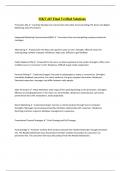MKT 415 Final Verified Solutions
Promotion Mix ✔️Carefully blended mix of promotion tools (Ads, Personal Selling, PR, Direct and Digital
Marketing, Sales Promotion)
Integrated Marketing Communication(IMC) ✔️Consistent clear and compelling company and brand
messages.
Advertising ✔️Produced for the Mass, fees paid for space or time. Strength: efficient means for
reaching large number of people. Weakness: High costs, difficult to get feedback
Public Relations (PR) ✔️Produced for the mass, no direct payments to the media. Strengths: Often most
credible source in consumer's mind. Weakness: Difficult to get media cooperation.
Personal Selling ✔️Customized target, Fees paid to salespeople as salary or commission. Strengths:
Immediate feedback, persuasive, Can select audience, Can give complex information. Weakness:
Extremely expensive, messages may differ between sales people.
Sales Promotion ✔️Mass Marketed, wide range of fees paid depending on the promotion. Strengths:
Effective at changing behavior in the short run, Very Flexible. Weakness: Easily abused, can lead to
promotional wars with competitors, easily duplicated.
Direct Marketing ✔️Customized target, Cost lies in communication through mail or computer.
Strengths: Messages can be prepared quickly, facilitates relationship with customers. Weakness:
Declining customer response, database management is expensive.
Promotional Channel Strategies ✔️Push Strategy and Pull Strategy
Push Strategy ✔️Producer markets their products towards the retailer/wholesaler though promotion
mix. The Retailer/wholesaler buys the product and then markets the product to consumers via
promotion mix. The consumer then buys the product from the Retailer/wholesaler.
,Pull Strategy ✔️Producer markets their product to the consumers through promotion mix. The
consumer then demands the product from the Retailer and wholesaler. In return, the retailer or
wholesaler demands their product from the producer to sell to the consumer.
What is Advertising? ✔️Any paid form of nonpersonal presentation and promotion of products (goods,
services, or information) by an identified sponsor.
Ads breaking through ✔️5000+ ads exposure per day, 362 "ads only" exposure per day, 153 "ads only"
noter per day, 86 "ads only" that gain awareness per day, Only 12 "ads only" made an impression.
4 Important decisions when Developing an Advertising Program ✔️1. Set objectives 2. Setting Budget 3.
Developing Advertising Strategy 4. Evaluating Advertising Campaign
Advertising Objectives ✔️Inform (brand value, image, new product, new uses, etc), Persuade
(Preference, switching, comparison, purchase, etc.) or Remind (Keep in mind, relationships, still need,
where to buy). All have the purpose to drive brand sales.
Advertising Budget ✔️Can be affordable, percent of sales, competitive parity, or Objective and Task.
Affordable: at the level management things company can afford, pros: its something, cons: often results
in underspending, ignoring the effect of promotion.
Percent of Sales: At a certain% of current/forecasted sales or as a % of the unit price. Pros: Simple to
implement and ties to promotion sales. Cons: Views sales as cause rather than effect.
Competitive Parity: To match competitor's outlays. Pros: Represents the collective wisdom of the
industry. Cons: Not tailored to company's needs.
Objective and task: Based on what the company wants to achieve. Pros: Forces Management to Spell
out the assumptions about the relationship between money spent and results. Cons: Difficult to use, not
100% controllable.
Developing Advertising Strategy ✔️Message Decisions and Media Decisions.
, Message Decisions entail developing a strategy and executing the message. Media decisions entail
impact and engagement, Major media types, specific media vehicles and media timing.
Message Decisions ✔️Current trends and Message strategy.
Major trends now: Breaking through the clutter through social media. Merging advertising and
entertainment by making the brand inseparable part of the content, or native advertising (making ads
natural content of social media.
Building Message Strategy: Message strategy statement Creative concept
Message Decision: Major creative Execution Styles ✔️1. Lifestyle 2. Fantasy 3. Mood or Image 4.
Musical 5. Personality Symbol 6. Slice of life 7. Technical expertise 8. Scientific evidence 9. Testimonial
evidence 10. Endorsement (look up examples of these)
Media Decisions: Media Advantages and Disadvantages ✔️Television: Adv, mass market appealing to
the senses Dis: High Total cost, fleeting
Radio: Adv: Good for Geo/Demo targeting, low cost. Dis: Audio Only, low attn.
Digitial/Social: Adv: Highly selective, opportunity for engagement. Dis: Potentially low impact
Newspapers: Adv: Credible, selective, timely, good local coverage. Dis: Short life, low production quality
Magazines: Adv: Credible, selective, long life, visually appealing. Dis: High cost, long lead times
Direct Mail: Adv: Highly selective, flexible, can be personalized. Dis: High cost/impression, "junk"
Outdoor: Adv: High repeat exposure, low cost. Dis: Low selectivity, creative limits




